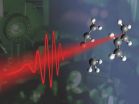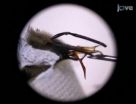(Press-News.org) Athens, Ga. – Long ago, when life on Earth was in its infancy, a group of small single-celled algae propelled themselves through the vast prehistoric ocean by beating whip like tails called flagella. It's a relatively unremarkable tale, except that now, more than 800 million years later, these organisms have evolved into parasites that threaten human health, and their algal past in the ocean may be the key to stopping them.
The organisms are called apicomplexa, but people know them better as the parasites that cause malaria and toxoplasmosis, serious diseases that infect millions of people every year, particularly in the developing world.
Now, researchers at the University of Georgia have discovered how an important structure inside these parasitic cells, which evolved from the algal ancestor millions of years ago, allows the cells to replicate and spread inside their hosts. Their research may soon lead to new therapies to halt these deadly pathogens before they cause disease.
In order to survive, the parasitic apicomplexa must invade an animal or human and force its way into the cells of its host. Once inside the host cell, the parasite begins to replicate into numerous daughter cells that in turn create additional copies, spreading the infection throughout the body.
In their study, published Dec. 11 in PLoS Biology, the researchers demonstrate that, during the process of replication, the parasite cell loads genetic material into its daughter cells via a strand of fiber that connects the two. By altering the genes for the components of the fiber in the laboratory, the researchers discovered that they could prevent parasite replication, making the parasite essentially harmless.
"These altered parasites can initially infect cells, but once we turn off the fiber genes, they cannot create new daughter cells and spread," said Maria Francia, lead author and doctoral candidate in the department of cellular biology. "Since it cannot replicate, the parasite eventually dies without causing serious harm."
This replication fiber appears to have evolved from the flagellum that ancient algae used to swim.
"This was a surprising finding," said Boris Striepen, a Georgia Research Alliance Distinguished Investigator in UGA's Center for Tropical and Emerging Global Diseases. "These parasites no longer use flagella to swim, but they have apparently repurposed this machinery to now organize the assembly of an invasive cell."
During evolution, flagella have been reengineered to serve numerous different functions in animals, including the sensors that allow us to see and smell. This study suggests that in these parasites structures used to invade host cells may be also derived from flagella.
Current treatments for diseases like malaria are threatened by the parasite becoming resistant to the drugs, so the need for new therapies is always pressing.
This algae-based connective fiber may serve as a promising target for anti-parasitic drug development, said Striepen, who is also a cellular biologist in the Franklin College of Arts and Sciences. He cautions, however, that more work must be done to learn how to manipulate or destroy the fiber in parasites that have infected humans or animals.
But both Striepen and Francia argue that scientists do well to pay close attention to the evolutionary history of the organisms they study.
"It is extremely important to understand the evolution of different organisms, but especially the evolution of pathogens," Striepen said. "The analysis of their evolution produces important opportunities to develop treatments, but it also helps us understand the basic structure of the pathogens that we must fight."
###
UGA Center for Tropical and Emerging Global Diseases
The University of Georgia Center for Tropical and Emerging Global Diseases draws on a strong foundation of parasitology, immunology, cellular and molecular biology, biochemistry and genetics to develop medical and public health interventions for at-risk populations. Established in 1998, the center promotes international biomedical research and educational programs at UGA and throughout Georgia to address the parasitic and other tropical diseases that continue to threaten the health of people throughout the world. For more information about the center, see http://ctegd.uga.edu.
Writer: James Hataway, 706/542-5222, jhataway@uga.edu
Contact: Boris Striepen, 706/583-0588, striepen@uga.edu
UGA researchers find algal ancestor is key to how deadly pathogens proliferate
2012-12-12
ELSE PRESS RELEASES FROM THIS DATE:
Ultra-short laser pulses control chemical processes
2012-12-12
This press release is available in German.
Chemical reactions occur so quickly that it is completely impossible to observe their progress or to control them using conventional methods. However, new developments in electrical engineering and quantum technology enable us to achieve a more exact understanding and improved control of the behaviour of atoms and molecules. At the TU Vienna, scientists have succeeded in influencing the splitting of large molecules with up to ten atoms using ultra-short laser pulses.
The flash of light which splits molecules
Splitting a ...
Older and younger chronic leukemia patients may need different therapy
2012-12-12
People who develop chronic lymphocytic leukemia (CLL) are typically age 65 and older, but participants in CLL clinical trials are usually several years younger;
The age of CLL patients is not usually considered when determining treatment;
This study suggests that older and younger CLL patients require different therapy.
COLUMBUS, Ohio – Doctors should use different therapies when treating older and younger patients with chronic lymphocytic leukemia, according to a new study led by researchers at the Ohio State University Comprehensive Cancer Center – Arthur G. ...
Researchers shed light on the workings of the body's immune response
2012-12-12
Researchers from Queen Mary, University of London have discovered that two proteins which are believed to play a key role in controlling the body's immune response are found in lower levels in T lymphocytes from patients with multiple sclerosis (MS).
The study found that MS patients' T lymphocytes – types of white blood cells which play an important role in the immune system – were defective at producing the proteins and that this was associated with increased levels of molecules which promote inflammation. The findings are reported in the Journal of Immunology¹.
The ...
Can algae-derived oils support large-scale, low-cost biofuels production?
2012-12-12
New Rochelle, NY, December 12, 2012—ExxonMobil and many other energy companies are investing hundreds of millions of dollars to develop transportation biofuels from renewable resources such as the oil or hydrocarbons produced by microalgae. As global supplies of fossil fuels continue to shrink, biofuels derived from algae represent one promising source of low-cost, scalable renewable energy. The feasibility and economic projections for large-scale biofuels production from microalgae are examined in a Review article and accompanying Commentary published in Disruptive Science ...
Novel test identifies patients most likely to benefit from ALK inhibition therapy
2012-12-12
Philadelphia, PA, December 12, 2012 – Approximately one in 20 patients with non-small cell lung carcinoma (NSCLC) has chromosomal aberrations targeting the anaplastic lymphoma kinase (ALK) gene. This has considerable implications for treatment because these patients are highly responsive to ALK-specific kinase inhibitors such as crizotinib. However, current diagnostic tests have limitations. Researchers have now developed and tested a promising new method for screening ALK fusions in NSCLC. This new diagnostic assay offers a cost-effective and easy-to-perform alternative ...
Frog-in-bucket-of-milk folklore leads to potential new antibiotics
2012-12-12
Following up on an ancient Russian way of keeping milk from going sour — by putting a frog in the bucket of milk — scientists have identified a wealth of new antibiotic substances in the skin of the Russian Brown frog. The study appears in ACS' Journal of Proteome Research.
A. T. Lebedev and colleagues explain that amphibians secrete antimicrobial substances called peptides through their skin. These compounds make up the majority of their skin secretions and act as a first line of defense against bacteria and other microorganisms that thrive in the wet places frogs, toads, ...
A promising clinical trial to reduce the severity of autistic disorders
2012-12-12
This press release is available in French.
Although this therapy is not curative, it nevertheless reduced the autistic disorders' severity in three-quarters of the children. The researchers have filed a request for authorisation to perform a multi-centre European clinical trial in order to determine more precisely the population concerned by this therapy.
Details of this work have been published in the Translational Psychiatry review dated 11 December 2012.
Contribution made by the fundamental research on neuronal chloride
Previous work carried out by the team of ...
New twist on using biomass for perfume, cosmetic, personal care products
2012-12-12
In a new approach for tapping biomass as a sustainable raw material, scientists are reporting use of a Nobel-Prize-winning technology to transform plant "essential oils" — substances with the characteristic fragrance of the plant — into high-value ingredients for sunscreens, perfumes and other personal care products. The report on the approach, which could open up new economic opportunities for tropical countries that grow such plants, appears in the Journal of the American Chemical Society.
Deryn Fogg, Eduardo dos Santos and colleagues explain that breaking down plant ...
New geometries: Researchers create new shapes of artificial microcompartments
2012-12-12
In nature, biological functions are often carried out in tiny protective shells known as microcompartments, structures that provide home to enzymes that convert carbon dioxide into energy in plant cells and to viruses that replicate once they enter the cell.
Most of these shells buckle into an icosahedron shape, forming 20 sides that allow for high interface with their surroundings. But some shells — such as those found in the single-celled Archaea or simple, salt-loving organisms called halophiles —break into triangles, squares, or non-symmetrical geometries. While these ...
Scientists train honey bees to stick out their tongues
2012-12-12
Honey bees are a highly organized, social species, as demonstrated by their complex colonies and the geometric structure of their hives. For hive building, the honey bee strongly relies on its tactile sense, and a new video-article in JoVE (Journal of Visualized Experiments) illustrates a novel tactile conditioning experiment using honey bees. The technique, presented by the lab of Dr. Volker Dürr of Bielefeld University, trains honey bees to stick out their tongues when their antennae touch an object. This procedure allows researchers to analyze how changes in antennal ...


